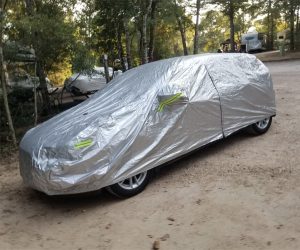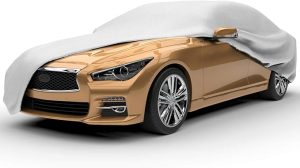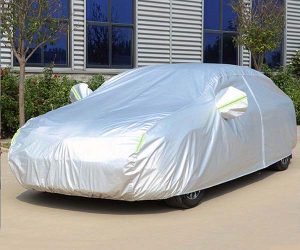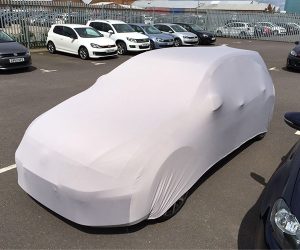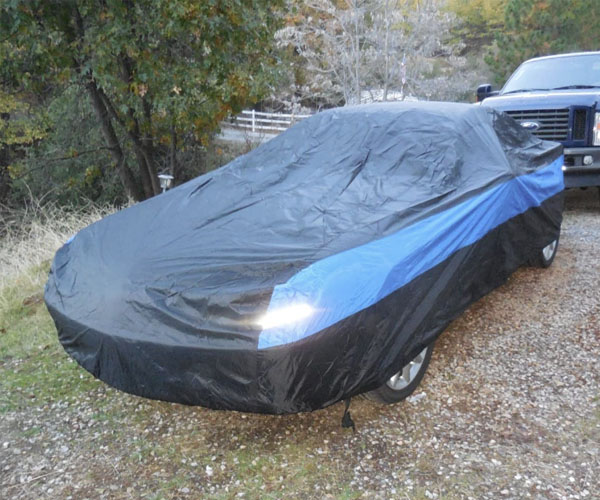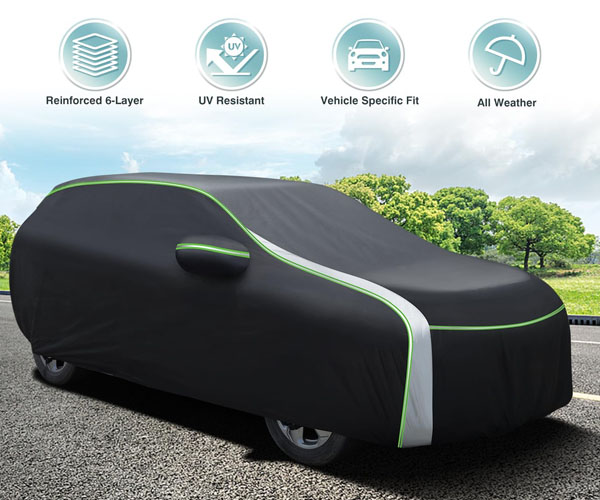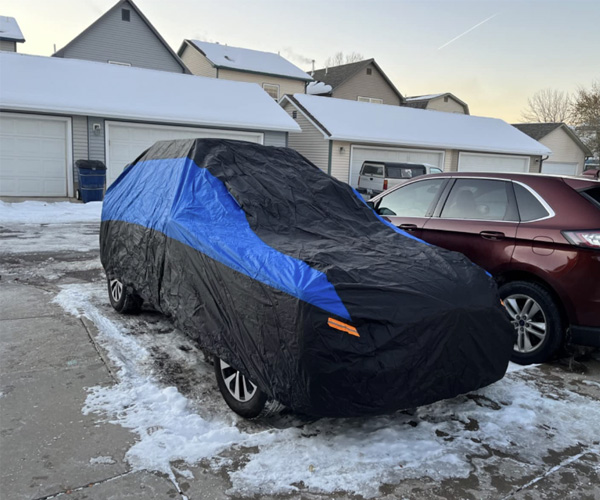The Best Car Covers for Hot Climates: Beat the Heat with These Picks
I. Introduction
Every automobile owner should prioritize protecting their vehicle when they live in an area where the sun shines continuously. This is where hot climate car coverings come in handy as necessary equipment for your vehicle. These coverings do much more than just protect your automobile from dust and debris; they are an essential defense against the sun’s harmful rays and the potential harm they may do. As we delve deeper into the subject, we’ll cover a variety of topics related to selecting the finest car cover for hot climes, with an emphasis on the types, features, and materials that work well in these harsh circumstances.
It is crucial to choose the appropriate vehicle cover in hot weather.
- Heat and UV Protection: A primary consideration for car covers in hot climates is their ability to reflect sunlight and provide UV protection. Prolonged exposure to intense sun can fade your car’s paint and damage its interior.
- Material Matters: The fabric of the car cover plays a significant role. It needs to be light enough to prevent heat accumulation while being durable enough to withstand the rigors of a hot climate.
- Breathability: In hot and dry areas, a breathable cover helps to reduce heat buildup and allows moisture and heat to escape, preventing damage to your car’s exterior and interior.
- Dust and Debris Protection: Hot climates can often be accompanied by windy conditions that bring dust and debris. A good car cover will protect your vehicle from such environmental factors.
- Custom Fit: A well-fitting car cover is essential in all climates, but in hot areas, it ensures that every part of the vehicle is shielded from the direct impact of the sun’s rays.
We’ll go into more detail about each of these topics as we go along, giving you a thorough guide to assist you in selecting the best car cover to ward off the heat. The longevity and aesthetic appeal of your vehicle are greatly enhanced by knowing the subtleties of car covers for hot climates, regardless of whether you live in a dry desert or an area with scorching summer temperatures.
No matter how high the temperature climbs, we want to provide you with all the knowledge you need to make an informed choice and keep your automobile safe, cool, and well-maintained. As we go out on our quest to find the best car maintenance options for hot regions, stay tuned.
II. Why Protecting Your Car in Hot Climates is Essential
Warm weather can make it quite difficult to keep your car in good shape and last a long time. It’s important to use car covers in hot areas to protect your automobile’s value and operation in addition to keeping it looking nice. The intense heat and unrelenting sun in these areas can seriously damage an automobile’s exterior and interior. This is why it’s so important to keep your car safe in these kinds of situations:
- Intense UV Rays: Prolonged exposure to the sun’s ultraviolet (UV) rays can cause substantial damage to your car. These rays can lead to:
- Fading paintwork, making the car look older and more worn than it actually is.
- Degradation of plastic trims and rubber seals, leading to costly repairs and replacements.
- Excessive Heat: Cars parked in the open in hot climates can experience interior temperatures that soar well above the outside air temperature. This excessive heat can:
- Damage the dashboard and upholstery, causing them to crack, fade, or even warp.
- Increase the wear and tear on electronic components inside the vehicle.
- Dust and Debris: Hot climates often come with dry, dusty conditions. Dust and debris can accumulate on and around your vehicle, leading to:
- Scratches and abrasions on the car’s surface when the dust is wiped off without proper cleaning.
- Clogging of air filters, which can impact the car’s performance and increase fuel consumption.
- Environmental Contaminants: Besides dust, other environmental contaminants like bird droppings, tree sap, and pollen are more prevalent in hot climates. These can:
- Corrode the paintwork if not cleaned off promptly.
- Cause unsightly stains that are difficult to remove.
An efficient technique to deal with these issues is to use automobile covers for hot weather. An appropriate car cover can lower the inside temperature of your car considerably, shelter it from damaging UV rays, and shield the outside of your car from dirt, debris, and other impurities. Furthermore, a high-quality vehicle cover made for hot areas will be:
- Breathable: Allowing air to circulate and preventing moisture buildup, which is crucial in preventing mold and mildew growth under the cover.
- UV-resistant: Specially treated to reflect UV rays and reduce the impact of solar heat.
- Custom-fitted: Ensuring a snug fit to provide maximum protection against environmental elements.
To sum up, if you want to keep your car functional and attractive, you must invest in a high-quality car cover for hot weather. For the substantial advantages it provides in terms of safeguarding your investment and maintaining the best possible condition for your car, the tiny cost is well worth it.
III. Key Features to Look for in a Car Cover for Hot Climates
Selecting the appropriate car cover is essential if you live in a hot environment in order to shield your car from the harsh sun and heat. There are a few important factors to take into account while searching for car coverings for hot weather in order to provide your vehicle with the best possible protection. These characteristics not only make the cover more durable, but they also guarantee that your car stays cool and is well-protected from the hot sun.
- UV Protection:
- The most essential feature of a car cover for hot climates is its ability to block harmful UV rays. Prolonged exposure to the sun can lead to fading of your car’s paint and interior. A cover with a high UV protection rating will shield your car from the sun’s damaging effects.
- Look for materials that are specifically treated for UV resistance. Covers made from polyester or polypropylene are often good choices as they provide excellent UV protection.
- Reflective Properties:
- A car cover with reflective properties is a game-changer in hot climates. Reflective covers bounce back the sun’s rays, significantly reducing the temperature build-up inside the vehicle.
- Opt for covers with a light color, such as silver or white, as they naturally reflect sunlight better than darker colors.
- Breathability:
- In hot and humid climates, a breathable car cover is indispensable. A cover that allows air circulation prevents moisture accumulation, which can lead to mold and mildew growth.
- Breathability is also important to release the heat that gets trapped under the cover, ensuring that the car doesn’t become an oven.
- Material Durability:
- The intense sun in hot climates can degrade materials quickly. Therefore, the durability of the material is a crucial factor.
- Look for covers made from high-quality, tear-resistant fabrics. Materials like acrylic or a blend of polyester and cotton can offer durability while still being lightweight.
- Custom Fit:
- A custom-fitted car cover is preferable in any climate, but it becomes even more important in areas with high wind conditions, often accompanying hot climates.
- A snug fit ensures that the cover stays in place, providing consistent protection and preventing the cover from flapping, which can damage the car’s paint.
- Ease of Use and Maintenance:
- Given that covers in hot climates need frequent washing due to dust and other particles, choose a cover that is easy to clean and maintain.
- Look for covers that are machine washable and dryable for convenience.
- Added Features:
- Features like reinforced grommets for tying down the cover can be beneficial in windy conditions.
- Some covers come with additional protective layers for added dust and scratch protection, which can be a bonus in hot, sandy environments.
In conclusion, it’s critical to consider UV protection, reflecting qualities, breathability, durability, custom fit, and simplicity of maintenance while looking for car covers for hot areas. Together, these elements make sure that your car is shielded from the sun as well as the other extreme elements that are common in hotter regions. Recall that the correct cover preserves your car’s appearance in addition to extending its lifespan.
IV. Top Picks for Car Covers in Hot Climates
Selecting materials and styles that provide optimal protection from strong sun, high temperatures, and UV rays is crucial when thinking about car covers for hot climates. The main concerns in hot areas are paint fade prevention, internal damage prevention, and making sure the cover itself can endure extended sun exposure. Here are a few of our best choices for car coverings that perform exceptionally well in these circumstances; each is specially made to protect your car from the intense heat.
- Reflective Polyester Covers:
- Description: Made from high-quality polyester, these covers are designed to reflect sunlight effectively, thereby reducing heat buildup inside the car. They are lightweight, making them easy to handle and store.
- Benefits:
- UV Protection: These covers are treated with UV inhibitors, which protect both the cover and your car from sun damage.
- Breathability: Allows air circulation, preventing moisture accumulation and heat buildup.
- Best for: Everyday use in areas with intense sunlight.
- Silver-Coated Covers:
- Description: These covers come with a silver coating that acts as a mirror, reflecting a significant amount of sunlight and UV rays.
- Benefits:
- High Reflectivity: Excellent for reflecting sunlight and keeping the car cool.
- Durable: The silver coating adds an extra layer of protection against wear and tear.
- Best for: Vehicles that are parked outdoors for long periods in sunny areas.
- Layered Fabric Covers:
- Description: Multi-layered fabric covers offer robust protection. The outer layer is typically designed to be UV resistant, while the inner layers provide padding and additional insulation.
- Benefits:
- Enhanced Protection: Multiple layers shield against not just the sun but also dust, bird droppings, and rain.
- Scratch-Proof: The soft inner layers protect the car’s paint from scratches.
- Best for: High-end vehicles or areas with fluctuating weather conditions, along with high sun exposure.
- Custom-Fit Solar Covers:
- Description: These are tailor-made to fit specific car models and are often equipped with solar-reflective materials.
- Benefits:
- Perfect Fit: A snug fit ensures complete coverage and protection.
- Optimized Protection: Materials specifically chosen for sun protection offer superior defense against UV rays and heat.
- Best for: Luxury and custom vehicles where precise fit and maximum protection are paramount.
- Ventilated Covers:
- Description: These covers come with built-in ventilators to facilitate air flow, significantly reducing heat accumulation.
- Benefits:
- Heat Reduction: The ventilators help in dissipating heat, keeping the car cooler.
- Moisture Prevention: Good air circulation prevents moisture-related issues like mold and mildew.
- Best for: Hot and humid climates where moisture buildup is a concern along with heat.
In conclusion, elements like UV protection, material reflectivity, ventilation, and durability must be taken into account while selecting the best car cover for hot conditions. There is a cover out there that suits your demands, regardless of whether protecting a high-end car or making regular protection for your family car is your top concern. Recall that purchasing a high-quality car cover adds to your vehicle’s longevity and resale value in addition to preserving its cosmetic appeal.
- Heat-Resistant Canvas Covers:
- Description: Crafted from thick, heat-resistant canvas material, these covers are designed to endure the rigors of extremely hot climates.
- Benefits:
- Robust Heat Protection: The thickness of the canvas provides a substantial barrier against the sun’s rays.
- Longevity: Canvas material is known for its durability and long-term resistance to wear and tear.
- Best for: Areas with extreme heat and strong sunlight, where durability is as important as heat protection.
- Lightweight Synthetic Covers:
- Description: These covers are made from lightweight synthetic materials that are easy to handle and store but still offer significant protection against heat.
- Benefits:
- Ease of Use: Their lightweight nature makes them easy to put on and take off.
- Effective Sun Protection: Though light, these covers still reflect a good amount of sunlight and UV rays.
- Best for: Daily drivers in sunny climates, where ease of use is a key concern.
- Waterproof and Heat-Resistant Covers:
- Description: Ideal for regions that experience both heavy rain and intense heat, these covers provide dual protection.
- Benefits:
- Dual Protection: Shields the car from both sun damage and water.
- Breathable Material: Prevents moisture accumulation under the cover.
- Best for: Tropical climates where rain and sun are both major factors.
- Aerodynamic Mesh Covers:
- Description: These covers are designed with aerodynamic mesh panels that allow wind to pass through, reducing the risk of the cover being blown away and also aiding in heat dissipation.
- Benefits:
- Wind Resistance: The aerodynamic design minimizes the risk of the cover being displaced by strong winds.
- Cooling Effect: Mesh panels allow for air circulation, contributing to cooling the vehicle.
- Best for: Windy coastal areas that also experience high temperatures.
- Eco-Friendly Natural Fiber Covers:
- Description: Made from eco-friendly materials like cotton, these covers are gentle on the car and the environment.
- Benefits:
- Sustainable Protection: Offers sun protection while being environmentally friendly.
- Soft on Paint: Natural fibers are less likely to scratch or damage the car’s paint.
- Best for: Environmentally conscious consumers looking for effective sun protection.
Each of these solutions meets different demands and tastes while providing unique advantages for protecting cars in hot weather. Think about your priorities, the requirements of your car, and the particular conditions in your location before making your decision. A carefully considered car cover may be an important asset in keeping your automobile in good shape and guaranteeing that it will be a reliable and prideful asset for many years to come.
V. DIY Tips for Enhancing Your Car Cover’s Heat Protection
When we explore the world of do-it-yourself vehicle cover improvements—especially for individuals who live in hot climates—it’s critical to concentrate on workable and efficient methods. These pointers are intended to improve your car cover’s ability to ward off heat, keeping your car cool and well-covered from the blazing sun. Recall that although car covers are a basic defense, a few adjustments can greatly increase their effectiveness in hot conditions.
- Reflective Material Additions:
- Consider attaching reflective materials, such as Mylar or aluminum foil sheets, to the upper layer of your car cover. This can be done by sewing or using heat-resistant adhesives. The reflective surface will deflect a substantial portion of the sun’s rays, thereby reducing the heat absorbed by the car cover.
- For those particularly hot climates, adding an extra layer of reflective material can make a noticeable difference in maintaining a lower temperature under the cover.
- Strategic Ventilation Holes:
- Adding ventilation holes at strategic locations can greatly enhance air circulation. This prevents heat buildup inside the cover. Ensure that these holes are small and positioned in areas less likely to expose the car to direct sunlight or moisture.
- Implement a mesh layer over these holes to keep out dust and debris while still allowing air to flow freely.
- Light-Colored Fabric Overlays:
- Dark colors absorb more heat, so covering your car cover with a light-colored fabric overlay can significantly reduce heat absorption. Materials like light cotton or polyester are suitable for this purpose.
- This is particularly effective for car covers used in hot climates, where the intensity of the sun can dramatically increase the car’s interior temperature.
- Moisture-Absorbing Pads:
- Inside the car cover, place moisture-absorbing pads at different areas, especially on the dashboard and seats. These pads will absorb any excess moisture that may build up due to heat, thereby protecting your car’s interior components.
- This method is crucial in areas with high humidity combined with hot climates.
- Layering with Heat-Resistant Materials:
- For an additional layer of protection, consider layering your car cover with heat-resistant materials like thermal bubble wrap. This not only reflects heat but also provides a cushioning effect to protect against physical impacts.
- Especially in hot climates, where the sun can be relentless, this extra layer can protect both the car cover and the vehicle from extreme heat damage.
- Regular Maintenance and Checks:
- Regularly inspect your car cover for any signs of wear and tear. In hot climates, the fabric can degrade faster due to intense UV exposure.
- Clean your car cover frequently to maintain its reflective and protective properties. Dust and dirt can hinder its ability to reflect sunlight effectively.
You can greatly improve the heat protection of your car cover and make it more appropriate for use in hot regions by putting these do-it-yourself ideas into practice. It strikes a balance between improving airflow, reflecting heat, and maintaining the material integrity of the cover, all of which help keep your car safer and colder. Recall that these improvements need to enhance rather than replace the car cover’s original qualities. To get the most out of your car cover, it needs to be properly maintained and adjusted to your local environment.
VI. Alternative Solutions for Car Protection in Hot Weather
There are particular difficulties with car protection in hot weather. Even though car covers are a common solution, it’s important to look at other options, particularly for those who live in hot, sunny areas. We’ll look at a number of solutions in this part that can protect your car from the heat and keep it in excellent shape even in the hottest weather. Recall that making the correct decision can greatly improve your car’s appearance and lifespan.
- Reflective Sun Shades:
- Ideal for those who park their cars outdoors during the day.
- Sun shades made from reflective materials can be placed inside the windshield and rear window.
- They reflect sunlight away, significantly reducing interior temperatures and protecting the dashboard from UV damage.
- Window Tinting:
- A more permanent solution, window tinting can block a substantial amount of UV radiation.
- Helps in maintaining cooler interior temperatures and preventing upholstery fading.
- Legal limitations on tint darkness should be considered based on your local laws.
- Carports and Parking Structures:
- A carport or a dedicated parking structure offers robust protection from direct sunlight.
- These structures can be built or installed at home or in office parking areas.
- They provide shade and significantly reduce the temperature inside your car.
- Regular Waxing and Paint Protection:
- Regular waxing creates a protective layer over the car’s paint, shielding it from UV rays.
- Investing in high-quality paint protection films can be a more durable solution.
- These films are designed to resist heat and protect the car’s exterior from fading and oxidation.
- Car Covers for Hot Climates:
- Selecting the right car cover is crucial in hot weather conditions.
- Car covers for hot climates should be lightweight, breathable, and UV-resistant.
- Look for covers with reflective properties to deflect sunlight and reduce heat build-up.
- Ventilated Seat Covers:
- Protecting the interior is as important as the exterior.
- Ventilated seat covers help in reducing the seat temperature and provide comfort in hot weather.
- They prevent the upholstery from fading and cracking due to excessive heat.
- Automated Cooling Systems:
- Advanced solutions include automated cooling systems that can be activated remotely.
- These systems start the air conditioning before you enter the vehicle, cooling the interior.
- While more expensive, they offer the ultimate comfort in hot climates.
- Proper Fluid Maintenance:
- High temperatures can affect your car’s fluids, including coolant and engine oil.
- Regular checks and maintenance ensure that your car’s engine stays cool and runs smoothly.
- This is essential for preventing overheating in hot weather.
- Using Cooling Car Seat Cushions:
- These cushions are designed to provide cooling effects during the drive.
- They can be particularly useful for long drives in hot weather.
- Parking in Shaded Areas:
- Whenever possible, park your car in shaded areas.
- This simple practice can significantly reduce the heat impact on your car.
By studying these choices and complementing them with suitable car covers for hot areas, car owners may effectively protect their vehicles from the harsh impacts of high temperatures and bright sunlight. Every choice has special advantages, and combining these options can yield the greatest defense for
your car in hot weather conditions. Keep in mind that how well you shield your car from the weather has a big impact on its lifespan and attractiveness. Your car can stay in great shape even in the blazing sun with regular maintenance and the appropriate protection techniques.
- Strategic Parking Choices:
- Opt for underground or covered parking when available, especially in urban areas.
- These parking options offer a natural barrier against heat and sunlight.
- Cooling Car Garments:
- A relatively new concept, these are specially designed garments that cover key areas of the car.
- They are easy to install and remove, and effectively protect against direct sunlight.
- Upgraded Radiator and Cooling System:
- Ensuring your car’s radiator and cooling system are in top condition is crucial in hot weather.
- Upgrades or regular maintenance can prevent engine overheating, a common issue in high temperatures.
- Using Thermal Insulating Car Mats:
- These mats are designed to reduce the heat absorbed by the car’s floor.
- They can keep the car cooler and protect electronic components situated under the car’s flooring.
- Investing in a Custom Car Cover:
- Custom car covers are tailored to fit your specific vehicle model.
- They offer a snug fit and better protection, especially if you choose materials suitable for hot climates.
You may greatly improve the protection of your automobile in the summer by combining these precautions with the usage of car covers for hot areas. It all comes down to developing a thorough plan that takes into account how much heat and sunlight your car will be exposed to. Using this method will not only keep your automobile looking good, but it will also make sure it works well and lasts through rough weather.
VII. Case Studies/Testimonials
This section delves into real-world accounts and testimonies that showcase the experiences of automobile owners utilizing various vehicle cover kinds, especially in hot weather conditions. These anecdotes not only bring the numbers and facts previously covered to life, but they also give readers a real sense of how car covers function in hot and muggy conditions.
- Case Study 1: The Desert Dweller
- Location: Arizona, USA
- Car Cover Used: High-reflectivity fabric cover
- Scenario: Protecting a car from intense sunlight and heat
- Outcome: The fabric cover, designed specifically for hot climates, successfully reflected the sun’s rays, significantly reducing the internal temperature of the vehicle. The owner reported a noticeable difference in the comfort level when entering the car and lessened wear on the interior due to UV exposure.
- Case Study 2: The Beachside Resident
- Location: Florida, USA
- Car Cover Used: Breathable plastic cover with UV protection
- Scenario: Balancing the need for sun protection and moisture control near the ocean
- Outcome: The cover provided excellent UV protection, preventing paint fading and interior damage. Its breathable nature also prevented moisture accumulation, a common issue in humid, seaside environments.
- Case Study 3: The Urban Commuter
- Location: Texas, USA
- Car Cover Used: Lightweight, reflective fabric cover
- Scenario: Daily use in a metropolitan area with high temperatures
- Outcome: The cover was easy to handle and quick to deploy, a significant factor for daily use. It effectively kept the car cooler and protected against sun damage, making it an ideal solution for the busy urbanite.
- Testimonial 1: The Seasoned Traveler
- Background: Regularly travels through various hot climate regions
- Experience: “Using a high-quality car cover made a world of difference in my travels through hot climates. The car covers for hot climates not only protected my car from the harsh sun but also made it more comfortable to get back into after a long day out. I highly recommend investing in a cover designed for high temperatures.”
- Testimonial 2: The Sunbelt Native
- Background: Lives in a region known for its year-round sunny weather
- Experience: “I never realized the impact of the sun on my car until I started using a sun-reflective car cover. It’s not just about the exterior; the reduced heat inside the car has been a game-changer for comfort and preserving the interior of my vehicle.”
The significance of selecting the appropriate car cover, particularly in hot regions, is highlighted by these case studies and testimonies. They show how different materials and designs may effectively shield cars from strong sunlight and extreme heat. Potential customers can have a better understanding of the useful advantages and make more educated choices when choosing car covers for their unique requirements and settings by sharing these first-hand experiences.
RFQ: Car Covers for Summer Heat and Protection
What is the best car cover for summer heat? The best car cover for summer heat is typically one made from a light-colored, reflective material that can deflect sunlight and ultraviolet (UV) rays. Covers made from breathable fabric are also ideal, as they prevent heat buildup by allowing air to circulate.
Do car covers protect from heat? Yes, car covers can protect from heat, especially those designed with reflective materials that repel sunlight and UV rays. They can significantly reduce the temperature inside the car, helping to maintain the interior and prevent the dashboard and seats from fading or cracking.
Which car cover is best for sun protection? For optimal sun protection, a car cover made of UV-resistant fabric with reflective properties is best. It should offer a tight weave and be treated for UV resistance to ensure it reflects the sun’s rays and protects the car from prolonged exposure.
Can you put a cover on a hot car? It’s generally safe to put a cover on a hot car as long as the cover is made of a heat-resistant material that won’t melt or stick to the vehicle’s surface. However, it’s always best to allow the car to cool down slightly to avoid trapping excessive heat.
When should you not use a car cover? You should not use a car cover when the vehicle is wet, as this can trap moisture and lead to mold or rust. Additionally, avoid using a
car cover in strong winds without proper fastening, as it can blow away or scratch the car. It’s also not advisable to use a car cover on a dirty car, as debris beneath the cover can scratch the paint.
What is a breathable car cover? A breathable car cover is designed to allow air to circulate through the material, preventing heat buildup and moisture accumulation. This type of cover is particularly beneficial in hot and humid climates, as it helps keep the car dry and cool while protecting it from the sun’s damaging rays.



